
Overview
In 2020, the COVID-19 pandemic changed the way in which the NHS delivered health and care services to our communities. With an estimated 25 million UK cases to date, this severe acute respiratory syndrome was responsible for 232,112 deaths.
In March 2020, the government introduced lockdown measures for our communities, and was not lifted again until May – replaced with new restrictions.
The COVID pandemic led to the largest fall in life expectancy in England since records began in 1981. The impact of the pandemic on the country’s healthcare system has led to increased waiting lists and a huge pressure on the NHS.
However, the pandemic impacted more than just our hospital and community settings. It changed lives forever, the way in which we deliver health and care services and our relationships with our wider communities.
Local schools and colleges were approached
To mark this moment in time, in April 2024 before the official formation of our visual arts council, an art brief was sent out and local schools and colleges were approached to ensure we could sensitively and respectfully commemorate the pandemic with an impactful piece of art.
Stockton Sixth Form College students’ submission was successfully chosen in December 2024 following the live brief, which saw stiff competition.
Students discuss their artwork – in their own words
[Interviewer] Hi Clair. Could you tell us – what does it mean for your arts department to have won this competition?
Clair: Well, it’s a really great honor to have won the competition. I understood that so many students, and so many colleges were entering the competition. I hoped that we might win, but I didn’t certainly didn’t expect us to win. It was excellent news when I had found out that Stockton Sixth Form College and the students would have work in North Tees and Hartlepool. Students can celebrate their success for both venues. It’s not just one venue. When I found out it was two – that was brilliant news. So I know it’s inspired them, not only to create their own their own artwork, but with a narrative in particular. So when people view their work there’s some meaning behind it. But also, they’re considering who’s going to see the work, you know? So it’s it’s been important to their education and also the fact that it just it means that their work’s been valued. Which is amazing. So hopefully when the work’s installed all the messages that students have portrayed will resonate with the viewers and people will enjoy the work as they walk past.
Nikita: My name is Nikita and mine is the newspaper piece. I was really happy that we were able to accomplish something and felt good knowing that our work was seen as amazing and worthy of display. My artwork represents the news telling during the years of COVID-19 and the continuous announcement of death, and health and safety advice during the difficult time. It means a lot, as it reminds me of the time where we were unable to see friends and family during the pandemic, and could only see each other through digital screens, which was difficult. My takeaway memory, is that we were able to accomplish something very difficult for such a long time and were able to get back on track years later.
Daisy: My name is Daisy. It was to show people about the queueing of when the covid jabs first – like everyone needed them because like there was always massive queues for them all. So like the needles were to represent the queues that they sat us in as well. It shows the amount of time everyone’s spent in queues waiting for them, and like me and my family as well. Remember being stuck in lockdown like on FaceTime my friends.
Finn: My name is Finn Clarvis and I designed a canvas symbolizing the difference between the business of hospitals and the quietness of home life during covid. I had the idea from the beginning, that I wanted to do how different people experience the pandemic. And then I came up with the haiku for my work. And it kind of all developed from there. It was important, because it showed how as a community how we stuck together, even though everything was different for everyone. And how the world was kind of closer than it’s ever been, even though the crisis was happening. I remember being very scared because it was uncertain and I don’t like uncertainty and also I couldn’t see some of my immediate family. So it was quite lonely at the time.
Lucy: I’m Lucy Fox. I go to Stockton Sixth Form College and I’m 16 years old. I was quite proud, a little bit surprised. I wasn’t expecting it, but then also very like excited and happy for myself and everyone else. Well the first thing I did was I wrote a haiku, and then I had to make it fit with my idea and then I painted my painting and designed the layout of the haiku to just look nice with the way I painted my painting. My painting represents how people can reflect on their struggles during covid and find strength in the fact that we persisted and are all still here now. I’d say it’s the way that it brought my family together, as we all had to support one another at the time, because we were all each other had. We used to have like family quizzes so it really brought everyone together.
Lily: I was quite surprised to be honest I didn’t really expect us to win really given that there was so many other colleges participating, but it was quite nice. For my artwork, I just thought of how everyone was all cooped up by themselves in like their own individual bubbles. Which is really where just the bubble idea came from. To me it shows just how distant and isolating the side effects of COVID can be. Probably my favorite memory is probably when we were first allowed to have one or two people join our bubble, and it was one of those like really hot days, and we got the pool out and my nana came around and it was the first time I had seen her in like a really long time.
Divine: My name is Mesole Divine. I’m an A level art student at Stockton Sixth Form College. I was happy because it’s an opportunity to send a message to, you know, everyone that visits the hospital. Remind them that we’ve been through a lot as humans because co affected the whole world. I mainly focused on the fact that the NHS is also made up of fellow humans, all coming together in our diversity, to make sure that everything goes okay, to make sure that we defeated COVID and everything. So, in my painting I used an umbrella as a symbol of hope. I used it as a symbol of the light in the darkness of COVID, and as as a symbol of protection. Because that’s what the NHS did during COVID. I believe that together we can do anything. When we come together in our diversity there’s no mountain we can’t overcome.
Maisy: I think everyone was very happy about it because there was a lot of schools in the area, or colleges which were very like high up like the Northern School of Art, very good and then we’re just a small unit. So I think winning it as a team and kind of putting a team effort in was nice for everybody. And made everyone happy. My piece of art was I wanted to signify that the full world was affected, not just parts and places. That everywhere was affected. And I think the mask kind of shows that it wasn’t just one it was everybody. And the words on the mask was kind of to link to the NHS and how they like supported everybody through covid. The piece of artwork, that I created, it was kind of a bit of closure you know. It was a bit of closure – Covid was done – I mean it wasn’t just my artwork that I wasn’t happy with It was everybody’s, it’s the project and the meaning of the project. And I think it kind of fit in with that. The artwork it was very good, I was really happy with it It was the poem I thought that all through but it was the pieces together, that really meant a lot. Um, my takeaway memory it’s got to be in the garden, you know I did love it. In the sun, my mom was also a key workerm nursem through covid. So I was obviously going to school still, but yeah she she worked in the hospitals. She was just a student nurse at the time. But yeah it was it was hard for everybody wasn’t it.
Emilia: Emilia based her work on the isolation we all felt during lockdown. Her artwork shows the lack of contact we had with our families, and the grief we experienced during that time.
Sophie: So I structured it – like I structured the concept around like the rainbow that was used in to represent covid at the time. When people were putting them in the windows and things, and I thought it sort of represented the sacrifices the NHS made, and also like the positive aspects of it. Like people got to spend more time with their families and like it was just yeah. Some of the positive aspects outweighed the bad ones. It was sort of like, showed the optimism that some people had, like with the sunshine and the rainbows. And it sort of showed how everybody came together and supported the NHS, and each other. It was like a it was a scary to start with obviously the like the country shutting down. But then um knowing everybody was together sort of helped bring like the positives back.
[OUTRO]
More about each piece
Nikita Chenjerai
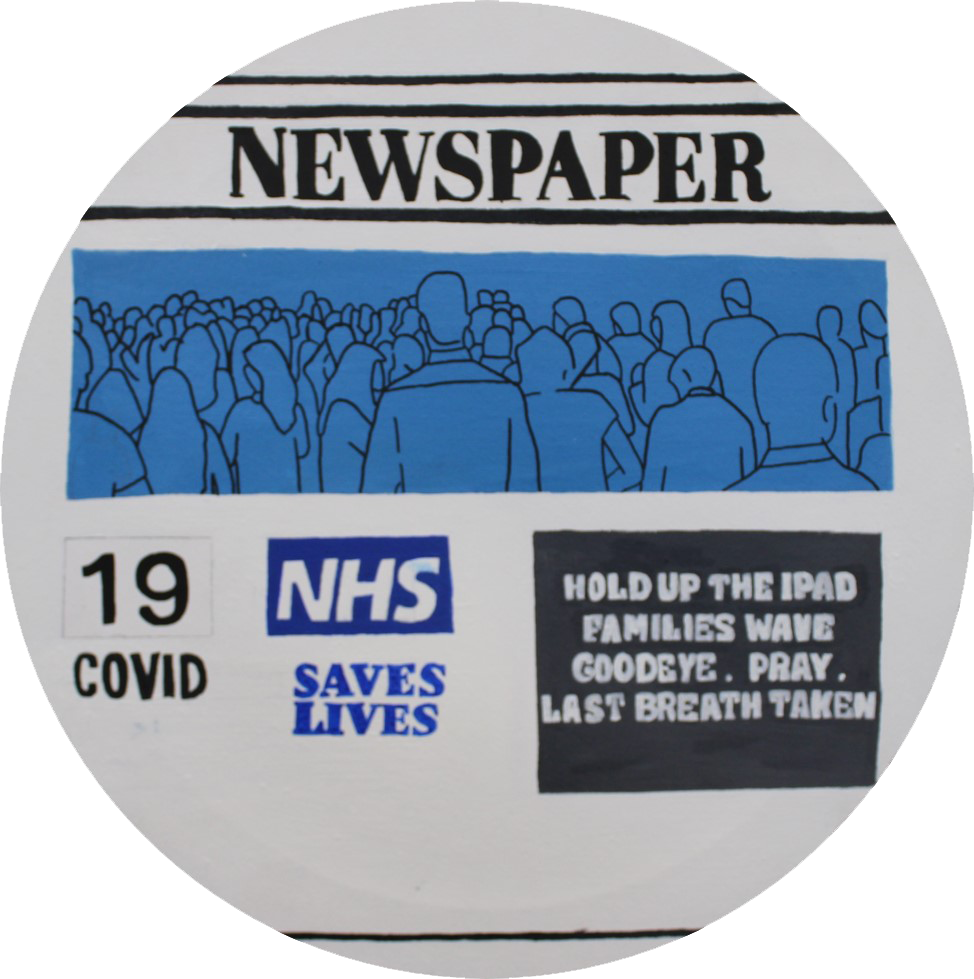
Hold up the iPad.
Families wave goodbye from screen.
Pray. Last breath taken.
For my composition I have created a piece that represents a news report during COVID-19 and how dependent people were on the NHS during the difficult time.
It also shows the distance that was put between loved ones during the pandemic, as people were only able to communicate through screens.
Daisy Bell
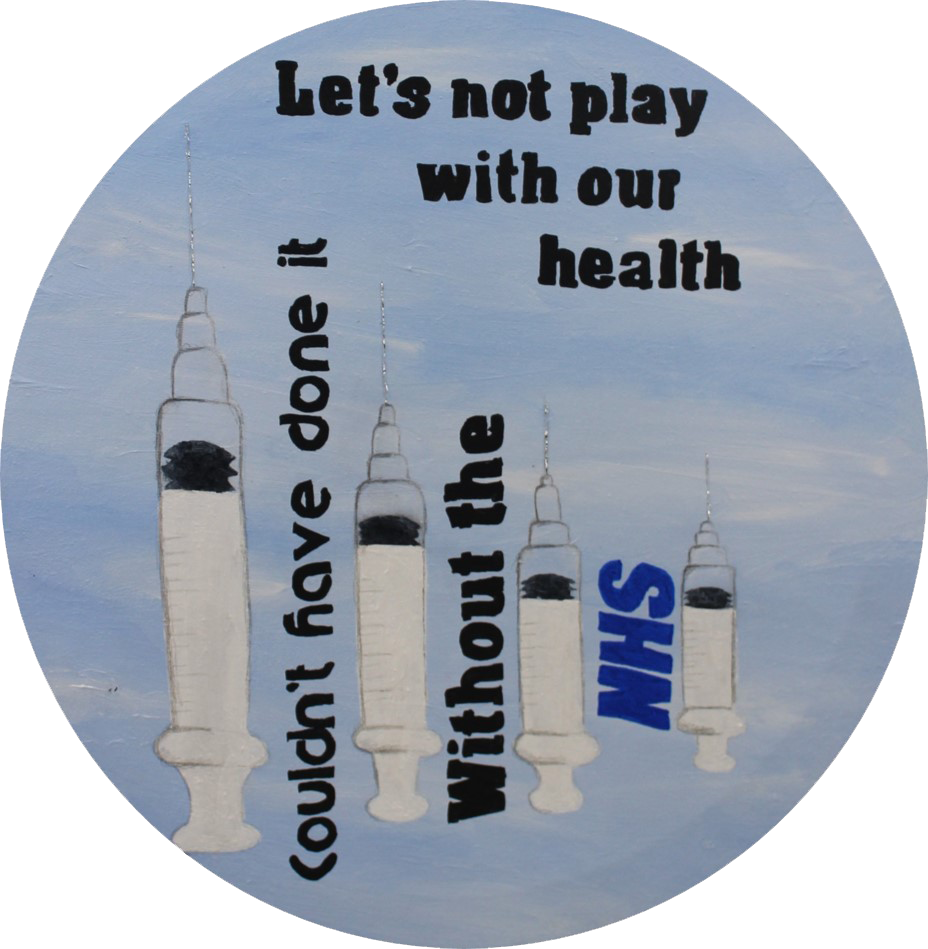
Let’s not play with our health.
Couldn’t have done it without the NHS.
Controlled the virus.
My idea for the COVID-19 memorial piece was to show how people would queue up for ages for their covid jabs, whilst also including a meaningful and heartfelt message.
I added text to show my support for the hard work the NHS do and everything they did during the pandemic. I painted the covid needles in a way that look as if they are queueing, to represent the many lines we formed during the pandemic.
Finn Clarvis

Busy to silent.
Our society struggled.
Yet support stayed strong.
My idea was to create a piece of artwork that demonstrated the silence of everyday life during COVID-19 times, in stark contrast to the busy hospitals that were overwhelmed with work. This is to emphasise that everyone had a different experience during this difficult time.
However, we all stuck together even if it was in a metaphorical sense. I have used the imagery of an empty corridor to symbolise isolation, and symbols that might represent the hospital or first aid to represent the workload of frontline workers.
Lucinda Fox
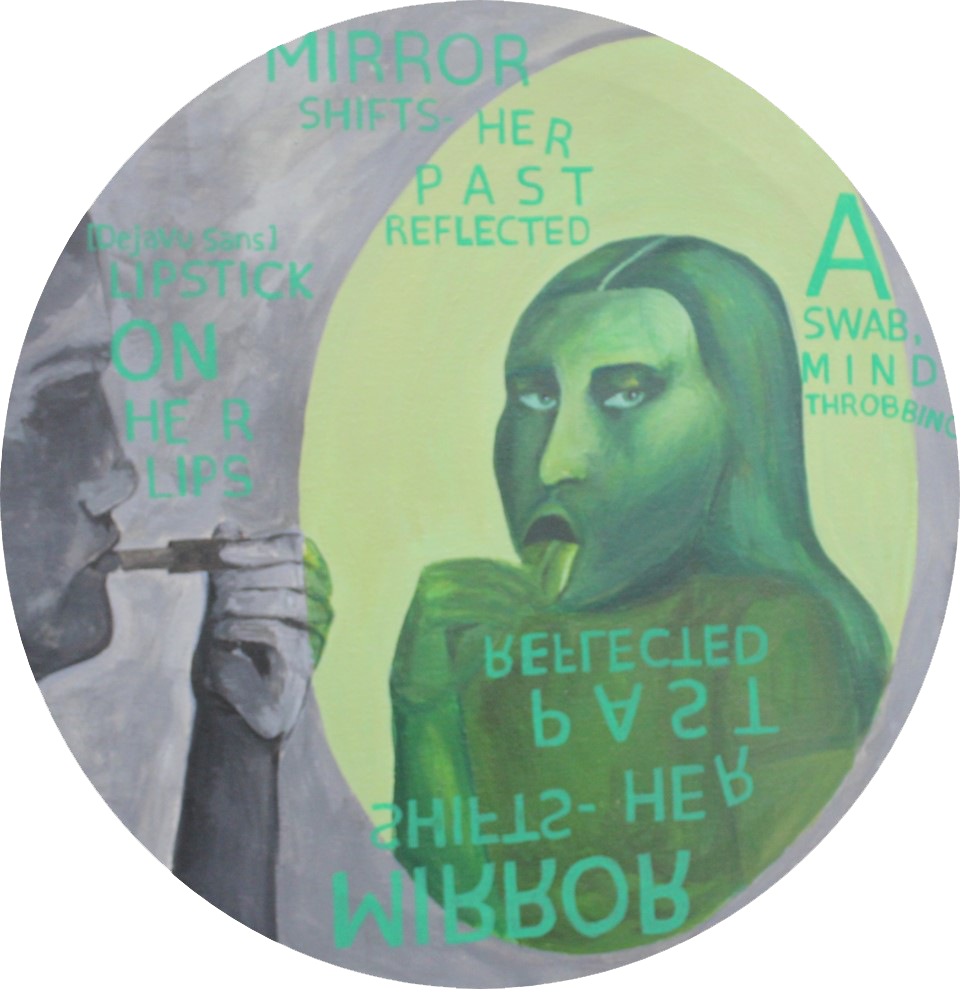
LIPSTICK on her lips.
Mirror shifts – her part reflected.
A swab, mind throbbing.
Initially I began to play around with the idea of showing life during COVID-19 versus now (after the pandemic). To show this I used the imagery of a mirror. On one side of the mirror would be a representation of life now and in the reflection would be the memory of life during covid.
I created the painting of a woman putting on lipstick in the mirror and in her reflection, she sees herself from during the pandemic doing a COVID-19 test. I made her reflection a sickly green colour to carry the message of illness, bleakness and the emotions both she and society would all have felt at the time.
The inclusion of the haiku is a literal form of narration showing what is occurring. The haiku has been ‘mirrored’ at the bottom of my canvas to further play with the idea of reflection. By showing this overall image of ‘now versus then’, I am hoping to inspire a feeling of hope from the viewer. An assurance that things get better no matter how much it may appear they will not.
Lily Kennedy

Introverted me.
Now completely misses hugs.
And those who gave them.
For my piece I focused on the ideas of being alone, separated and how the pandemic came to affect everyone globally because at first, the lockdown was probably great for most people. But, as it became longer and time went on more people began to suffer with severe loneliness. For some this turned to depression, as being alone is one of the hardest things, especially during a crisis when all you need is something as simple as a hug.
For my composition on the canvas I painted a variety of bubbles, with one central bubble being the focus. In this central bubble, I painted a silhouette to represent being alone and how everyone was put into ‘isolation bubbles’. In two others I painted a mask and a world, to represent how masks had become normalised for people to wear for safety as everyone came to be affected by the global virus.
I also featured multiple words relating to COVID-19 layered on top of one another to symbolise the confusion people had to endure. My haiku was also quite personal to me because I like my alone time just like other people – but for that extended amount of time without physical touch or connection with other family members was tough.
Divine Mesole

Let the battles of yesterday.
Remind us today.
That we can win the battles of tomorrow.
I created a painting that symbolises unity during the COVID-19 pandemic. I used a rainbow umbrella to represent hope and protection, showing how we can come together to keep each other safe.
I highlighted the essential role of the NHS, acknowledging healthcare workers’ dedication during the pandemic. I included the phrase, “Let the battles of yesterday remind us that we can win the battles of tomorrow,” to inspire hope and a thought of our past struggles while looking forward to a brighter future.
Maisy Thomas
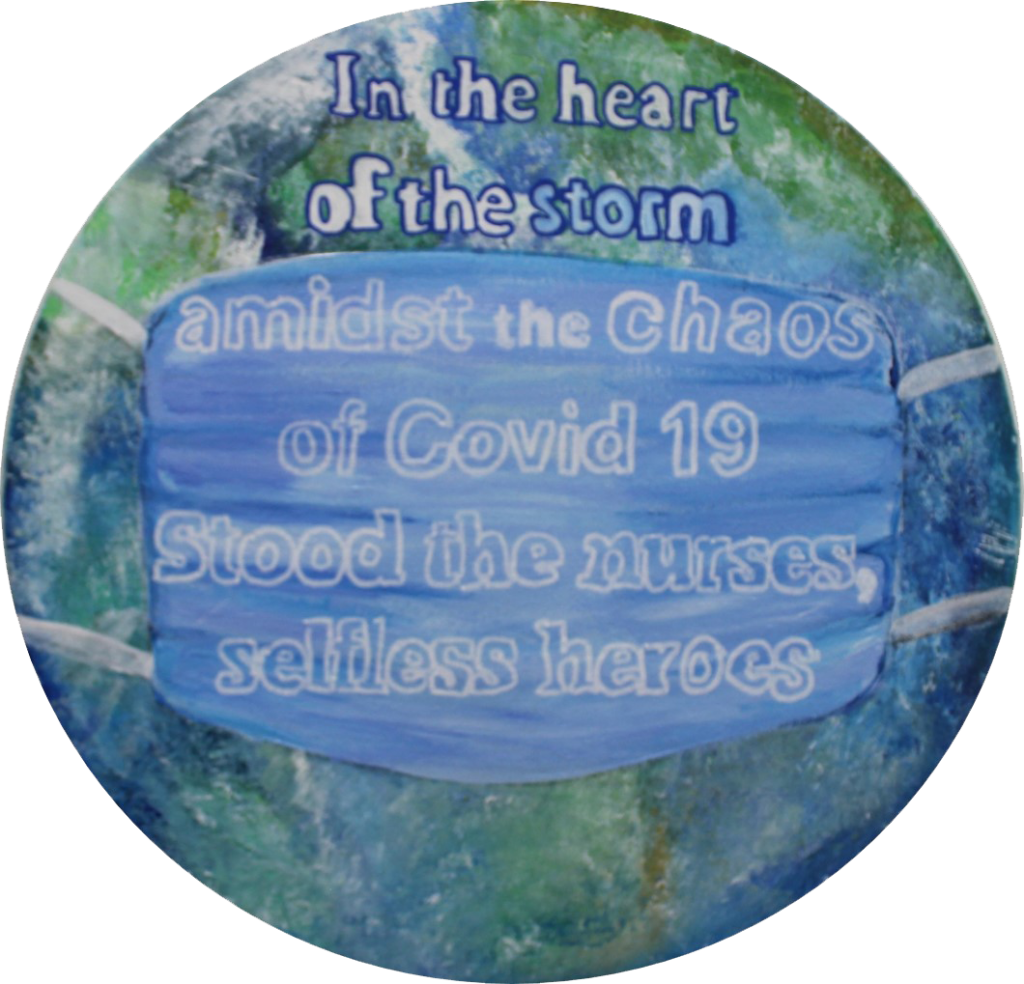
In the heart of the storm.
Amidst the chaos of COVID-19
Stood the nurses, selfless heroes.
My bubble is a composition of a COVID-19 mask wrapped around the world, with a message that relates to how the NHS is the protection of our country “in the heart of the storm, amidst the chaos of COVID-19 stood the nurses selfless heroes.”
I got this idea from thinking about our country throughout the rough time of the pandemic and the pressure that the NHS would be feeling working to save the population. When looking at my composition, I almost want the viewer to feel and draw on their memory of the battle our country had and the losses of loved ones, but to also understand that our country as a whole was affected and that everybody as a community was driven to fight this battle.
My fellow classmates and I all created a bubble each, however, they all show different messages. This is significant because everyone’s covid bubble was different. However, we were still all close as a community and our artwork creates a message as a whole, expressing our own thoughts.
Emilia Vaughan
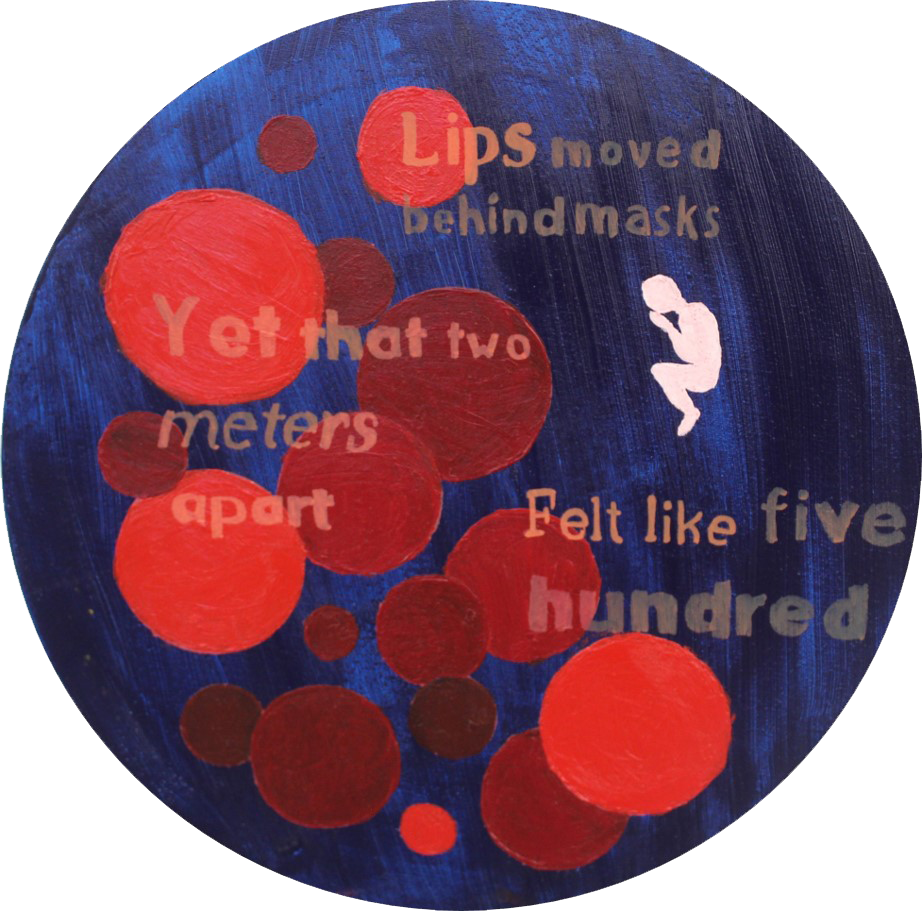
Lips moved behind masks.
Yet that two meters apart.
Felt like five hundred.
Emilia based her work on the isolation we all felt during lockdown.
The lack of contact we had with our families, and the grief we experienced during that time.
Sophie Wilks

Together we worked hard.
To help the NHS.
When given the brief I wondered how I would be able to combine the feelings of pain and isolation with those of celebration now that our world has returned to a somewhat similar version of what it used to be.
I tried to convey this message with the use of the covid mask, symbolic of all of the time we spent trapped within one, and the rainbow – which to me, represents all of the time we spent outside. Those evenings that every door on the street would be open with people clapping their hands, or banging pots and pans together, in honour of the NHS who supported us all through the pandemic.
As a class, we each created our own ‘bubble’ – inspired by what the government would call the tiny social circle we were allowed during each lockdown. They all carry unique meaning, as each piece conveys how we as individuals perceived the COVID-19 pandemic as a whole – they summarise our experiences and our emotions (both good and bad).
I hope that my own piece attracts the audience’s attention, firstly to the rainbow as to me that represents the hope and optimism that we all had during this difficult time, and then to the covid mask and the text, as they’re both representative of the troubles we faced as a nation. I wanted the piece to convey a mixture of emotions, and I believe I have achieved that through my use of colour and the multiple different shades of each that I had to create to show tone and dimension within the composition. For the centre of the piece, I wanted to use the NHS logo as a way of thanking them for their hard work and honouring them in an appropriate and considerate way.
How to change language in your browser
If you would like to read this page in another language, your browser has the option to change language or translate a page.
Google Chrome
You can use Chrome to translate a page into other languages.
- On your computer, open Chrome.
- Go to a page that you want to translate.
- On the right of the address bar, select Translate . You can right-click anywhere on the page and select Translate to [Language].
- Select your preferred language.
Apple Safari
How to translate a webpage in Safari on an iPhone
- Open Safari and navigate to the webpage you want to translate.
- Look for the “aA” icon located on the left side of the address bar. …
- Tap the “aA” icon and a menu will appear. …
- Select “Translate to [Your Device Language]”.
Microsoft Edge
- On the Microsoft Edge homepage, click on the three dots on the top right corner of your browser.
- At the bottom of the drop-down menu, click on Settings.
- At the button on the left-hand menu, click on Languages.
- Click on Add languages in the top-right corner.
Mozilla Firefox
In the General panel, scroll down to Language under Language and appearance. Click the Choose button next to Choose your preferred language for displaying pages to see your list of languages.